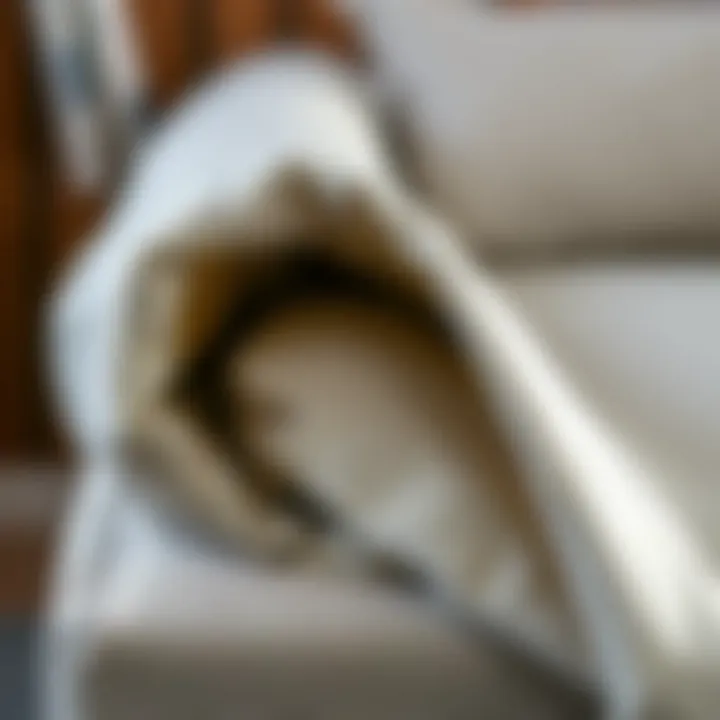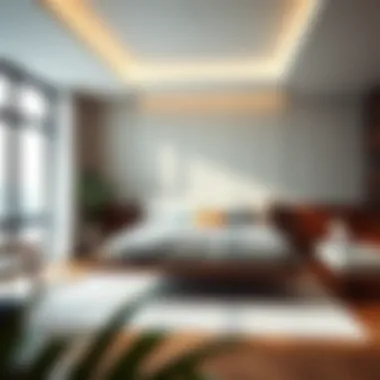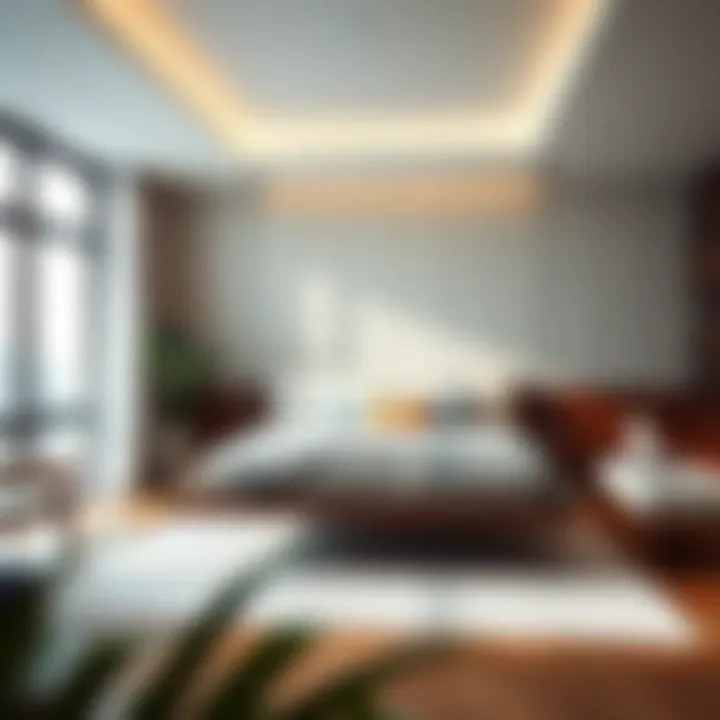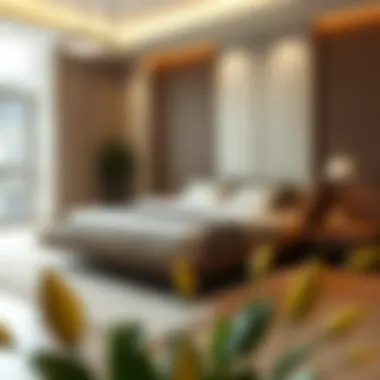Discover the Benefits of King Size Floating Bed Frames


Intro
Floating bed frames have becoming increasingly popular, capturing the imagination of homeowners and designers alike. The king size floating bed frame, in particular, stands out as both a functional and aesthetic centerpiece for modern bedrooms. What makes these frames unique is not just their appearance but also their influence on the overall look and feel of the bedroom. As we explore this design marvel, we will delve into key features, material choices, and practical tips that help maximize the benefits of such furniture.
Understanding the distinct characteristics of king size floating bed frames is essential to making an informed purchase. These beds often create a sense of spaciousness and minimalism, making them ideal for those looking to enhance their living space. With the right aesthetic choices, a floating bed frame can truly transform an ordinary bedroom into a modern sanctuary.
Taking this a step further, we'll also touch on the various maintenance aspects, ensuring that your floating bed frame lasts for years without losing its charm. This comprehensive guide aims to equip readers with the necessary insights to elevate not just their bedrooms, but their overall home decor philosophy.
Furniture Design Trends
Current Styles and Themes
When it comes to floating bed frames, our current design landscape reveals an impressive mix of styles. Many homeowners opt for minimalist Scandinavian designs, where clean lines and natural materials like wood dominate the aesthetic. However, there is also a rise in the popularity of industrial styles, where metal and distressed wood combine to create an urban vibe.
Another theme worth noting is the eco-friendly movement, which emphasizes sustainability. Beds crafted from reclaimed wood or bamboo not only support a greener environment but also impart a unique character to the space. The floating feature of these beds offers a sense of lightness, promoting an airy feeling regardless of the style chosen.
Color Palettes and Materials
Color plays a vital role in determining the overall impact of furniture in a room. In the realm of floating bed frames, neutral tones such as white, beige, and soft grays are immensely popular; they're versatile and can easily blend into various decor styles. On the other hand, deep colors like navy blue or forest green are making waves, particularly in more dramatic setups.
In terms of materials, wood remains a frontrunner, often coupled with fabric or leather accents. High-density foam mattresses are also commonly paired with these frames, ensuring comfort is not compromised in the name of style. Choosing the right material can greatly enhance the overall experience of the bedroom space, adding to its elegance.
"The material you choose does not only affect the frame's beauty but its durability too."
Practical Furniture Tips
How to Choose the Right Size
Selecting the right size for a king size floating bed frame involves more than just picking the largest option available. It’s vital to measure your bedroom to assess space availability and ensure there's enough room for walkways and additional furniture. A well-sized bed can enhances the flow of a room—too large and it feels cramped, too small and it might look lost.
Maintenance and Care for Longevity
Maintaining a floating bed frame involves simple yet essential practices. Regular dusting with a soft cloth can prevent wood from gathering grime. For any fabric components, consider vacuuming them occasionally to avoid buildup of dust or allergens.
It's also crucial to stay mindful of the frame's construction. Ensure that the hardware is tight and stable to prevent any wobbling or issues over time. Following these guidelines not only prolongs the life of your bed frame but also helps to ensure that it remains a stunning focal point in your bedroom for years to come.
For further reading, you may find these resources helpful:
As we blend functionality with elegance, king size floating bed frames indeed challenge the conventional notions of bedroom design. They demand our attention not just for their looks, but for the thought they bring to how we arrange our private spaces.
Foreword to Floating Bed Frames
When it comes to bedroom design, the bed often serves as the focal point. Enter the floating bed frame, a design trend that not only captivates the eye but also elevates the concept of space utilization. This section sheds light on the essence and advantages of floating bed frames, especially in the context of king-size models. The key to understanding their importance lies in recognizing how they blend innovation with functionality, infusing style and comfort into any bedroom setting.
Definition and Concept
Floating bed frames are designed to give the illusion that the bed hovers above the floor, creating a feeling of lightness and openness. This is achieved by employing clever construction techniques and supports, often mounted on walls or equipped with a compact base that is recessed into the floor. Each frame, particularly king-size ones, caters to larger spaces, making them suitable for individuals who enjoy not only ample sleeping space but also a blend of artistry and practicality in their bedroom.
The core concept revolves around simplicity and minimalism. Rather than bulky, traditional designs that often overwhelm a room, floating frames encourage an airy ambiance. This allows other design elements—like wall art or cushions—to shine without competing for attention. The overall effect transforms the sleeping area into a serene retreat, drawing the eye upward and enhancing the sense of space.
Historical Context
The concept of the floating bed isn’t just a modern fad; it has roots in various design philosophies that date back to the mid-20th century. Originally popularized by minimalist and avant-garde movements, these designs aimed to revolutionize living spaces by challenging conventional aesthetics. Styles like Japanese Zen or Scandinavian minimalism embraced the idea of simplicity and integration with nature, reflecting a philosophy that furniture should enhance, rather than overshadow, the living environment.
In contemporary times, the floating bed has resurfaced, gaining traction within modern interior design circles. With advancements in materials and technology, manufacturers have adapted the floating bed frame to meet today’s standards of comfort, durability, and aesthetic appeal. People increasingly appreciate the harmony such designs bring to their homes. As tastes change and evolve, the floating bed frame stands as a testament to the enduring appeal of innovative design.
Benefits of King Size Floating Bed Frames
Floating bed frames are more than a passing trend in contemporary home design. They represent a unique synergy of aesthetics and functionality that brings a fresh perspective to interior spaces. With growing attention towards home improvement, homeowners and decorators alike appreciate the myriad benefits of opting for a king size floating bed frame. Here’s a closer look at what makes them stand out.
Space Optimization
A primary advantage of using a king size floating bed frame lies in its ability to optimize space within a bedroom. Many people might think of a king size bed as too cumbersome for limited space; however, floating designs cleverly mitigate this perception. They create an illusion of openness, lifting the bed off the ground and providing visual airiness.
- Increased Floor Space: With a bed elevated, the floor area appears larger, allowing for more creative room layouts without the clutter that can accompany traditional frame styles. This is particularly useful in smaller rooms where every square inch counts.
- Storage Solutions: Some floating bed models feature compartments or built-in drawers, utilizing the space beneath the bed efficiently. This practical element combines style with functionality, enabling homeowners to store items without sacrificing aesthetic appeal.
- Flexible Layouts: Floating beds lend themselves to more flexible room configurations. For instance, you can rearrange other furniture with ease without feeling boxed in by bulky bed frames. This adaptability is especially valuable for those who frequently refresh room designs.
Aesthetic Appeal
The modernity of floating bed frames contributes significantly to their aesthetic allure. They often feature clean lines and a minimalist style that can complement various design themes, from ultra-modern to rustic chic.
- Visual Lightness: Many designs give the impression that the bed is gently hovering, which can create a serene and comfortable atmosphere. This light visual presence can make a room feel tranquil and spacious, an effect often sought after in bedroom design.
- Customization Flexibility: With floating beds, options abound regarding materials and finishes. Homeowners can select from sleek metal frames, warm wooden designs, or even upholstered varieties, allowing them to tailor the bed to match existing decor.
- Statement Piece: A king size floating bed can serve as an eye-catching focal point in any bedroom. The unique design can draw attention and create a conversation piece in your personal space, transforming an otherwise ordinary room into a stylish haven.
Enhanced Functionality
Floating bed frames don’t just look good; they also side-step many of the functional drawbacks related to traditional bed frames, leading to a more satisfying user experience.
- Improved Cleaning: Given that floating beds usually sit above floor level, cleaning beneath the bed becomes hassle-free. Dust and dirt can’t go unnoticed, promoting better hygiene within the bedroom environment.
- Better Airflow: Elevation off the ground allows for better airflow around the mattress, which can ultimately contribute to a more comfortable sleep environment. Improved ventilation can help in regulating temperature, reducing moisture buildup, and keeping mattresses in better condition.
- Easier Integration: These frames can fit seamlessly into various styles of bedrooms. Whether you have an ultra-modern home or a traditionally styled abode, floating beds can integrate beautifully, enhancing the overall functionality and aesthetics of the space.
"A king size floating bed frame combines functionality with sleek design, proving to be a wise choice for modern homeowners looking to upgrade their bedrooms."
In essence, the benefits of king size floating bed frames cut across style, space efficiency, and functional advantages. For those seeking to instill modernity and practicality in their bedroom design, these bed frames offer a chic and sensible solution.
Design Principles of Floating Bed Frames
When it comes to king size floating bed frames, design principles play a crucial role. They not only define the bed's aesthetic but also influence its functionality, sustainability, and overall user experience. A well-designed floating bed frame can elevate the ambience of a room, offering a balance of style and practicality. Each element—minimalism, material selection, and color choices—shapes how the frame interacts with its surroundings.
Minimalist Aesthetic
The minimalist aesthetic is at the heart of floating bed designs. It embodies simplicity that encourages calmness and clarity in a space. The essence of minimalism lies in its focus on essential elements, stripping away any unnecessary features. This approach can lead to a serene bedroom environment, promoting relaxation. A floating bed, with its clean lines and sleek design, complements the straight lines found in modern decor.
"Less is more" is not just a phrase; it’s a crucial principle in designing spaces where floating bed frames reside. By maintaining an uncluttered look, homeowners can highlight the unique features of their beds without overwhelming the room.
The foundation of the floating effect often relies on clever mounting systems that keep the frame off the ground, making the bed appear to float. This can effectively create an illusion of spaciousness, particularly beneficial for smaller bedrooms where every bit of visual space counts. All things considered, a minimalist design not only enhances aesthetic pleasure but also encourages a more mindful approach to living.
Material and Construction
Material selection is another pivotal aspect of floating bed frame design. The best choices are those that strike a balance between durability and aesthetics. Solid woods like oak or walnut can offer a classic look, while metals can provide an industrial edge that may resonate with contemporary styles.


When considering construction, attention to detail is paramount. A sturdy frame is essential for providing support, especially when it comes to king size beds that typically experience higher weight loads.
- Wooden Frames: Strong, classic, and warm. Great for coziness.
- Metal Frames: Sleek, modern, ideal for urban lofts.
- Engineered Woods: Cost-effective, versatile, good for various designs.
Moreover, the construction process can impact longevity. A well-engineered floating bed should include reinforced joints and quality hardware to ensure stability. The assembly of these frames often includes integrated support systems which are crucial for maintaining the ‘floating’ effect while accommodating weight comfortably.
Color and Texture Choices
Color and texture are the final touches that can transform a floating bed from ordinary to extraordinary. Light colors such as whites and soft pastels can enhance the illusion of space and light, making the room feel airy and open. On the other hand, darker hues can evoke elegance and create a cozy retreat.
Texture also plays a significant role; combining different textures can add depth and interest to a design. For instance, a smooth wooden frame paired with soft bedding can offer a tactile contrast that invites touch.
- Light Colors: Perfect for maximizing openness.
- Dark Hues: Create warmth and intimacy.
- Textured Fabrics: Enhance comfort and visual appeal.
Choosing the Right King Size Floating Bed Frame
Selecting the right king size floating bed frame is pivotal for several reasons, particularly when considering the overall design and functionality of your bedroom. A carefully chosen bed frame can serve as the room's central piece, creating a space that reflects your personal style while also ensuring comfort.
Moreover, the right frame is crucial for optimizing space and enhancing overall aesthetics— two factors that can significantly contribute to the feel of the environment. The floating bed style offers a distinctive look that can make a statement while saving space, a perfect combination for today’s living.
Material Considerations
When choosing a floating bed frame, materials play a vital role. The durability and strength of a bed frame are directly linked to its construction materials. Commonly used materials include wood, metal, and sometimes a combination of the two.
- Wood: Wooden frames can deliver warmth and a touch of nature. Hardwoods like oak or maple are known for their strength and longevity, whereas softer woods like pine offer a more budget-friendly alternative while still giving off a rustic charm.
- Metal: On the other hand, metal frames are often celebrated for their modern aesthetic and strength. Steel frames, in particular, provide excellent support and can handle heavier weights, giving them an edge in durability.
- Composite Materials: Innovations in technology have led to the rise of composite materials, which combine different elements to offer flexibility in design without compromising on strength.
When considering your options, it's advisable to think about the overall style of your bedroom. For example, a minimalist approach might favor sleek metal over bulky wood, while a traditional design might lean toward rich wooden structures.
Dimension Specifications
King size floating beds typically come in standard dimensions, but it's fundamental to ensure that you select a frame that perfectly fits your space. Standard king size mattresses measure 76 inches wide by 80 inches long. However, the dimensions of the bed frame can vary. Before making a purchase, measure your room and consider:
- Space Around the Frame: Aim for at least 24 inches of space on three sides of the bed for easy movement.
- Height of the Frame: A floating frame can appear higher or lower based on its design. If you have low ceilings, a lower profile might be advantageous to maintain balance in the room's proportions.
- Customization Options: Some manufacturers offer customized dimensions—something to consider if you have a specific design in mind.
Weight Capacity and Support
Understanding weight capacity is critical, especially for a king size bed that accommodates multiple sleepers. Floating bed frames often have a unique design support system that distributes weight evenly. Here are a few points to consider:
- Support Design: Most floating beds use slats for mattress support rather than a solid foundation. Ensure that the slats are appropriately spaced to avoid damaging the mattress and affecting comfort.
- Weight Ratings: Generally, you should look for frames with a higher weight capacity than expected, allowing for any additional items on the bed, like heavy bedding or supportive pillows.
- Assembly and Stability: It's crucial to ensure that the bed frame's assembly is solid. Poor construction can lead to instability, compromising safety and comfort.
"A well-chosen bed frame does not only uplift the decor but also enhances the overall sleeping experience."
In summary, selecting the right king size floating bed frame hinges on understanding materials, dimensions, and weight support. A keen eye on these elements can lead to a choice that marries form with function seamlessly, providing you with a piece of furniture that elevates your bedroom aesthetics while ensuring comfort for years to come.
Room Aesthetics with Floating Designs
When it comes to designing a bedroom, aesthetics plays a crucial role. One notable trend that has been sweeping across interior design is the inclusion of floating bed frames, especially king-sized ones.
The elegance and unique appeal of floating designs can transform a room in ways that traditional furniture scarcely can. The floating aspect provides an open, airy feeling, creating a sense of space that is paramount in modern design.
Impact on Bedroom Design
Floating bed frames are not just about style. Their impact on overall bedroom design is substantial. They can create a focal point, drawing the eye and commanding attention. By positioning a king size floating bed frame in your bedroom, it becomes the star of the show. The shadows cast by such a design can add depth, and its elevation can make the room appear larger.
Furthermore, floating bed frames can effectively enhance the flow of the space. They provide a clean line of sight, making it easier for one to move around the room. This is especially beneficial in smaller spaces where every inch matters. Homes that feature high ceilings can take full advantage of floating designs, allowing for striking contrasts with ceilings, light fixtures, and other decor elements.
Coordinating with Existing Furniture
To harmonize a floating bed frame with existing furniture, it's essential to hold a visual dialogue across the room. The color palette of the bed frame should echo the hues found in other furniture pieces. When selecting your floating bed frame, one might consider lighter wood tones or neutral colors that complement a variety of styles.
For instance, if your dresser is dark wood, a contrasting light-colored floating bed may help to visually balance the room. Equally important is the choice of textiles and accessories. Bed linens, cushions, and throw blankets can be used creatively to connect the floating bed to other pieces in the room. This synergy fosters an inviting atmosphere that feels cohesive and well-thought-out.
Creating a Cohesive Look
To truly achieve a cohesive design with a floating bed frame, one needs to consider the broader theme of the bedroom. If your overall style is minimalist, then a floating bed frame with clean lines will fit seamlessly. You could further underscore this look by incorporating minimalist bedside tables and simple artwork.
Alternatively, if you wish to inject a bit of personality, use various textures and materials around the bed frame. Pair soft bedding with industrial metal nightstands for an unexpected mix that still feels balanced.
It's also worth exploring how accessories like rugs or lamps can tie the room together without overpowering the central piece. For instance, a plush area rug underfoot can warm the space while enhancing the floating effect. > A well-organized layout with minimal clutter around the floating design can elevate your personal retreat, making it feel spacious yet cozy.
In essence, integrating a king size floating bed frame into your home calls for thoughtful consideration of various elements. Understanding its impact on your room's design, coordinating it with your existing furniture, and crafting a cohesive look can transform ordinary sleeping spaces into truly remarkable havens.
Installation and Setup Guidance
When it comes to floating bed frames, the installation and setup process plays an integral role in ensuring that both functionality and appearance are achieved. Often viewed as a complicated endeavor, getting a king size floating bed frame in place can be broken down into manageable steps, allowing homeowners and DIY enthusiasts alike to enjoy a satisfying project that enhances their living space. Not only does proper installation maximize the benefits of the bed frame, but it also helps prevent any potential disasters down the line.
Step-by-Step Installation Process
Installing a king size floating bed frame doesn’t have to be a daunting task. Here’s a clear, step-by-step guide to lead you through the process:
- Prepare the Space: Clear the area where the bed will be installed. This includes removing any existing furniture or obstacles that might hinder the setup.
- Assemble the Tools: Gather all necessary tools, which include a level, measuring tape, drill, and screwdrivers, among others (details in the next section).
- Measure Carefully: Before securing anything, measure the wall to determine the correct height for the installation. The bed should hover comfortably above the floor yet remain accessible.
- Mark the Wall: Use a pencil to mark where the brackets will go on the wall. Ensure the marks are level, as this will directly affect the frame's stability.
- Install the Brackets: Drill holes into the marked spots and attach the wall brackets securely. Verify that they’re aligned properly by running the level across.
- Secure the Frame: Attach the floating bed frame to the installed brackets. Ensure it’s snug and adjust as necessary until everything feels secure.
- Final Adjustments: Double-check stability and make any fine adjustments. Ensure that the frame is level so it doesn’t tip or rock.
- Make the Bed: Finally, put together your bedding and enjoy the stunning new focal point in your bedroom.
By following these steps, you’ll have your floating bed frame installed and ready for usage in no time.
Tools and Accessories Required
Having the right tools at your disposal is crucial for a seamless installation experience. Here’s a list you may find useful:
- Drill and Drill Bits: Essential for creating holes in the wall.
- Level: To ensure the bed frame is mounted straight and securely.
- Measuring Tape: Accuracy in measurements is key to proper installation.
- Screwdriver (Philips/Straight): For attaching screws to brackets.
- Stud Finder: Helps locate wall studs for a more secure installation.
- Pencil: For marking measurements on the wall.
- Wall Anchors: In case of need for extra support in drywall.
Equipping yourself with these tools can lead to a more efficient and successful installation process.
Common Setup Mistakes to Avoid
Even the best-laid plans can go awry if certain pitfalls aren’t avoided. Here are a few common mistakes that may trip you up:
- Not Checking for Studs: Failing to locate wall studs can lead to an unstable frame. Always use a stud finder.
- Ignoring Level Measurements: If the bed isn’t level, it can cause an uncomfortable sleeping experience.
- Ignoring Weight Limitations: Ensure that the frames you choose are capable of supporting the intended weight without risk.
- Overtightening Bolts: While securing is vital, overtightening can damage the structure.
- Neglecting Space for Accessories: Consider leaving space for bedside tables or lamps while installing.
By steering clear of these common mistakes, you can enjoy a smooth installation process and ensure that your floating bed frame is both sturdy and stunning.


Maintenance of Floating Bed Frames
Keeping a floating bed frame in tip-top shape is about more than just aesthetics; it’s an essential part of ensuring longevity and functionality. These beds, while uniquely designed to enhance bedroom appeal, also require a fair amount of care to maintain their beauty and effectiveness over time. Understanding how to clean and regularly maintain your floating bed frame can save you from some hefty repair costs down the line and keep your space looking fresh and inviting.
Cleaning Materials and Techniques
To start with, when it comes to cleaning your floating bed frame, the right approach can make all the difference. Here are some tried-and-true cleaning techniques:
- Microfiber Cloths: These soft cloths are excellent for dusting off surfaces without scratching the material.
- Gentle Cleaners: Use pH-balanced cleaners for materials like wood. Avoid harsh chemicals that can strip finishes or cause damage.
- Soft Brushes: For upholstered models, a soft brush can help remove dust from crevices without causing harm.
When cleaning, follow these steps for an effective process:
- Dust Regularly: A quick dusting with a microfiber cloth or duster can prevent build-up.
- Spot Clean Stains: Use a damp cloth with mild soap to address any stains promptly, but ensure you dry the area afterward.
- Avoid Excess Moisture: Whether it's wood or upholstery, excess moisture can lead to warping or mold, respectively.
"A clean space is a happy space. Keep your floating bed frame spotless to ensure it’s always inviting!"
Regular Maintenance Practices
Besides cleaning, certain regular maintenances can keep your floating bed frame performing well:
- Check Hardware: Periodically inspect screws, bolts, and brackets to ensure they’re not loose. Tightening these helps maintain stability.
- Inspect for Damage: Take a minute to look for any signs of wear and tear, like scratches or dents, which can affect both aesthetics and structure.
- Refinish Wooden Frames: If your floating bed frame is made of wood, consider refinishing it every few years to rejuvenate its look and protect it from elements.
Creating a maintenance schedule can be quite helpful. Here’s a simple breakdown:
- Monthly: Dust and check hardware.
- Every Three Months: Deep clean and inspect for any damages.
- Annually: Consider professional cleaning or refinishing if necessary.
By paying attention to these maintenance aspects, a floating bed frame can remain a centerpiece of creativity and comfort in your bedroom for many years to come.
Potential Challenges with Floating Bed Frames
Floating bed frames exude a modern and chic charm, appealing to many who wish to elevate their bedroom's design aesthetic. However, as with any home furnishing, there are challenges that come with their installation and usage. Understanding these potential hurdles can help homeowners, interior decorators, and DIY enthusiasts make well-informed decisions that suit their living spaces.
Structural Stability Concerns
One of the foremost concerns when considering a floating bed frame is its structural stability. Unlike traditional frames that sit firmly on the ground, floating frames rely on wall mounts and configurations that may raise apprehension among users. It’s vital to ensure that the walls and the anchors used can withstand the weight of the bed and the occupants. An inadequately secured bed can lead to wobbly nights or even dangerous falls.
Many designs emphasize sleek designs, which can sometimes translate to lighter materials. This, however, doesn't mean that they should be compromised on support. It is advisable to consult with professionals or refer to instructional materials while installing, ensuring that all components, from wall brackets to the frame, are robust and rated for their intended load.
Height Considerations
Height plays a crucial role when deciding on a floating bed frame. One might think that a floating design would offer a unique vantage point, providing an impressive look, but it’s essential to consider how this positioning interacts with the room's entire environment.
For shorter individuals or those with mobility issues, climbing into a higher bed can prove cumbersome. On the other hand, a frame that is too low might not provide the desired airy feel and could lead to discomfort in getting in and out of bed. Finding a balanced height that complements the room while catering to the personal preferences of its users is crucial. Installing a mattress on a floating frame could also change the overall height, and measuring beforehand can save heartache later.
Adaptability to Various Spaces
Another aspect worth considering is the adaptability of floating bed frames to different room designs and layouts. Given their unique nature, these frames often come with specific requirements regarding space and layout. In smaller bedrooms, a floating frame's sleek and suspended design can help create an illusion of a larger area, but fitting one into an odd-shaped room may not be as straightforward.
It's also essential to consider the overall theme of the existing interior design. A modern floating bed may look out of place in a rustic or traditional room unless carefully integrated with complementary pieces. Therefore, adaptability is not just about spatial fit, but also about aesthetic harmony among various elements in the room.
Epilogue
Examining these potential challenges will not only aid you in making an informed choice but also enhance your overall experience with floating bed frames. With careful consideration and appropriate planning, many of these concerns can be addressed, allowing you to enjoy the distinct advantages these beds have to offer.
"In the world of design, understanding the 'why' behind a choice is just as important as the choice itself."
For more information on floating bed frames and design considerations, check resources like Wikipedia or explore communities on Reddit for shared experiences.
Cost Considerations
When it comes to floating bed frames, particularly the king size variety, understanding the cost implications is vital for homeowners or anyone looking to enhance their bedroom's aesthetics. These frames aren’t just a trend; they represent a substantial investment in comfort and style. Discussing the costs gives a clearer picture of what one can expect in terms of both upfront investment and long-term value.
Price Ranges for Materials
The material used in floating bed frames significantly impacts their price. High-quality materials not only enhance the frame's durability but also affect its aesthetic appeal. Here’s a breakdown of typical price ranges based on material:
- Wood Frames: You can expect to find solid wood frames ranging from $800 to $2,500, depending on the type of wood and craftsmanship. Oak and walnut tend to be on the higher end, while softer woods like pine can be cheaper but may not offer the same longevity.
- Metal Frames: These generally range from $600 to $1,500. Aluminum frames tend to be on the lower end whereas steel will demand a higher price due to its sturdiness.
- Upholstered Frames: If you prefer a touch of luxury, these can cost between $1,000 and $3,000. This price encompasses the frame's structure as well as the fabric.
- Custom Designs: Tailored options can significantly increase the price, often ranging from $2,500 to $5,000 or even more, based on unique features or designer labels.
Careful consideration of these ranges and the type of frame you envision is essential in budgeting effectively for your floating bed.
Long-term Financial Considerations
Investing in a floating bed frame does involve initial costs, but it’s equally important to think about long-term financial considerations. This means recognizing the value that comes with quality.
- Durability: A well-made floating bed frame often lasts for years, potentially outlasting cheaper alternatives that could require replacement. This affects not just the cost of the bed but also ongoing expenses like disposal or purchasing new frames.
- Resale Value: High-quality furniture tends to hold its value better than lower-priced pieces. If you ever decide to part ways with the frame, you could regain a chunk of your initial investment, particularly with pieces made from solid wood or designer manufacturers.
- Maintenance Costs: Depending on the chosen material, maintenance can vary. Wooden frames might need occasional polishing or treatment to prevent wear. In contrast, metal and synthetic materials often require less upkeep, saving potential expenses down the line.
- Psychological Investment: Beyond the financial aspect, the comfort and satisfaction a high-quality bed frame can bring is invaluable. This psychological element can indirectly influence other costs, such as better sleep leading to enhanced productivity or improved mental health.
Investing in a floating bed frame is not just about the purchase price; it’s an investment in your comfort, health, and overall living environment. Carefully assess cost factors before making that leap.
Sustainability Aspects
Sustainability has become a cornerstone for contemporary living, deeply influencing design decisions, consumer choices, and manufacturing processes. In the context of king size floating bed frames, embracing sustainability not only enhances aesthetics but also aligns with the growing awareness of environmental stewardship among homeowners and designers alike. When considering the procurement and use of floating bed frames, delving into eco-friendly practices can not only protect our planet but also elevate the entire ambiance of a living space.
Eco-Friendly Material Options
When it comes to selecting materials for king size floating bed frames, a myriad of eco-friendly options abound. Here’s a breakdown of some prime candidates:
- Bamboo: This hardy plant matures rapidly and requires minimal water compared to traditional timber, making it a darling of the eco-conscious.
- Reclaimed Wood: Sourced from old buildings or furniture, reclaimed wood breathes new life into the design while reducing waste. Each piece carries its own history, adding character and a story to your bedroom.
- Natural Fiber Upholstery: Using materials such as organic cotton or linen for bed frames can significantly reduce the environmental impact since they are biodegradable and produced without harmful chemicals.
- Metal Frames: Opting for steel or aluminum can also be a sustainable choice, as these materials are often recyclable and durable. They offer a modern edge that complements various design styles.
Choosing these options not only contributes to a greener planet but also gives a unique touch to the bed frame with varied textures and styles.
Impact of Floating Designs on Resource Conservation
Floating bed frames embody a thoughtful approach to resource conservation in several ways:
"The beauty of floating designs lies in their ability to utilize space efficiently, leaving less waste in their wake."
- Less Wood Waste: Floating bed frames typically require fewer materials than traditional bed frames, as the design is streamlined and integrated into the wall or floor. This reduction in material usage diminishes deforestation and lessens demand on lumber resources.
- Energy Efficiency: Many floating bed designs are engineered for efficiency, often incorporating LED lighting or smart technology, reducing energy consumption in the home. Smart design choices can promote longevity, ensuring that the frame remains a staple in the home for years.
- Minimal Transport Costs: Lightweight designs often translate to reduced shipping emissions. A bed that’s relatively easy to assemble may mean smaller packaging and less environmental impact during transport.
In summary, opting for a king size floating bed frame that utilizes eco-conscious materials and embraces an efficient design can significantly enhance your lifestyle, leaving a smaller footprint on our planet while enriching your home's overall look.


Comparing with Traditional Bed Frames
When looking at bed frames, the floating kind stands out. Understanding the differences between king size floating bed frames and traditional bed frames is crucial. It’s not only about how they look but also how they function in a space. This section will dissect these differences, focusing on what sets floating beds apart.
Differences in Design and Functionality
Floating bed frames often flaunt a sleek, low-profile appearance. Unlike traditional bed frames that typically rest on legs or a box spring, floating beds appear to hover. This design creates an illusion of more open space which many folks find appealing, especially in smaller bedrooms.
- Visual Lightness: Floating frames often utilize a minimalistic design, making the space feel less cramped. Traditional frames can be bulky and may dominate the room.
- Storage Options: Many floating bed frames come with integrated storage solutions that can save space. You won't find a lot of traditional frames offering this convenience.
- Support Mechanisms: Floating beds usually have a unique support structure that doesn't require the standard support offered by traditional frames. Many use a slat system that allows for proper ventilation of the mattress, potentially extending its life.
This functionality offers both aesthetic and practical advantages that resonate with modern design trends, which prioritize simplicity and efficiency.
User Preferences and Trends
User preferences in bedroom setups have been shifting towards modern and minimalist designs. The rise in popularity of floating beds mirrors a broader trend in home decor where homeowners are seeking to maximize their space’s style without compromising on comfort.
- Customization: Many people nowadays prefer options that allow them to personalize their furniture. Floating bed frames often come in various materials and colors than traditional frames, which may just stick to a few classics.
- Sustainability Factor: As eco-consciousness grows, products made from sustainable materials have become increasingly appealing. Many floating bed designs incorporate reclaimed wood or non-toxic finishes, which attract buyers looking to reduce their carbon footprint.
- Tech Integration: It’s not uncommon to find floating beds that accommodate smart technology. The integration of features like under-bed lights or charging stations caters to a modern lifestyle, something traditional frames usually lack.
In summary, while traditional bed frames have been around for ages and have their merits, the floating bed frames present significant advancements in both style and utility. This is particularly relevant for the demographic that values contemporary aesthetics and efficient use of space.
Real User Experiences
Real user experiences provide a window into the everyday realities of owning a king size floating bed frame. This insight can be invaluable for potential buyers who want to grasp the practicality and satisfaction derived from such a significant purchase. By analyzing feedback from actual users, we unearth both the glowing endorsements and the challenges faced. A bed isn’t just a piece of furniture; it’s an element that can transform one’s entire sleeping experience and the aesthetic of a room.
Positive Feedback and Highlights
Most users who opt for king size floating bed frames highlight their modern design as a key advantage. These frames often garner compliments from visitors, creating a talking point in home décor. Here are some common positives shared:
- Sleek Aesthetics: Many users appreciate the minimalist approach of floating bed frames. Their ability to provide a clean, streamlined look helps create a sense of spaciousness in a room. A user mentioned how her new frame made her small bedroom feel like a chic retreat rather than a cluttered space.
- Increased Floor Space: The elevation provided by a floating frame can make a room feel larger. Owners often revel in how much easier it feels to clean under the bed, as one user noted that dusting has become a breeze since switching to a floating frame.
- Unique Design Features: Many frames allow customization options like built-in lighting or storage compartments. For instance, a user shared how the integrated LED lights added a touch of ambiance he never knew he needed.
One enthusiastic user proclaimed, "This frame has completely changed my sleep quality. It's like floating on air!"
Common Complaints and Solutions
Despite the glowing experiences, no product is without its issues. Some users reported challenges or aspects that could be improved:
- Stability Concerns: A few buyers expressed worries about the sturdiness of their floating frames, particularly with larger mattresses. Users suggested checking weight specifications and ensuring the bed frame is adequately anchored to prevent wobbling.
- Height Issues: Some consumers found their floating bed frames to be lower than anticipated, making it difficult for some individuals to get in and out of bed comfortably. Solution-wise, purchasing a memory foam or box spring mattress can mitigate this height issue.
- Assembly Troubles: A common theme in user complaints involves the complexity of assembly. Several noted that the instructions provided were lacking clarity. To tackle this problem, users recommend watching DIY assembly videos online or reaching out to customer service for assistance.
"As beautiful as it looks, don’t skip on support. I had to reinforce mine to feel secure about its stability," wrote one user in a popular home furnishing forum.
Ultimately, gathering real user experiences underscores the importance of research. Understanding the advantages and potential drawbacks arms consumers with the right tools to make informed purchasing decisions. Numerous factors can impact satisfaction, from aesthetics to practicality, shaping the owner’s day-to-day life. Through these insights, we can appreciate the deeper narrative of floating bed frames that mere specifications often overlook.
Trends in Floating Bed Frame Designs
The appeal of floating bed frames, particularly in king sizes, reflects a broader inclination towards contemporary design in modern homes. As the terminology of 'floating' suggests a minimalist aesthetic, the trends surrounding these structures are not only visually striking but also deeply rooted in a shift towards smarter living spaces. Understanding these trends is crucial for homeowners and designers aiming to not only restyle interiors but also to embrace functionality through innovative practices.
Innovative Materials and Technologies
When it comes to floating bed frames, the materials used have evolved significantly. Here’s a quick rundown:
- Plywood and Engineered Wood: These materials have become staples due to their lightweight nature while still providing necessary strength and style.
- Metal Frames: Sleek, enduring, and often powder-coated for a luxe finish, metal options have surged in popularity, offering a contemporary edge.
- Smart Technologies: Some innovative frames include built-in LED lighting and temperature control features. Imagine a bed that adjusts to your body heat!
These advancements cater not just to aesthetic preferences but also to the demands of modern-day living where technology seamlessly integrates into home furnishings.
When a frame meets functional innovation, users enjoy the comfort of modern engineering paired with style.
The emergence of these materials aligns with eco-conscious practices. For instance, companies are increasingly focusing on sustainable resources, such as bamboo or reclaimed wood, which lend a unique charm while promoting environmental responsibility.
Design Variations Across Cultures
Design does not exist in a vacuum; it fluctuates and morphs depending on cultural cues. Floating bed frames are no exception. The influence of diverse cultures can yield unique designs that are both functional and expressive.
- Japanese Aesthetics: Minimalism thrives here; futon-inspired designs with low profiles and clean lines are commonplace.
- Scandinavian Influence: This design ethos leans heavily on functionality, often featuring lighter woods and pairing bed frames with natural textiles.
- Middle Eastern Designs: Inspired by intricate carvings and vibrant fabrics, these floating frames may come with exotic upholstery that tells a story.
Understanding these variations is essential for decorators and designers, particularly when looking to create a harmonious blend within existing spaces or when catering to specific client preferences. Incorporating elements from these various cultures can enrich the experience of a sleeping space, making it uniquely personal while still adhering to the principles of modern design.
With these trends in mind, floating bed frames not only represent a functional piece of furniture but also embody the spirit of contemporary living that values both beauty and practicality.
Future of Floating Bed Frames
The evolution of floating bed frames marks a significant shift in both design and functionality within the furniture landscape. As we look ahead, the future of these bed frames promises exciting trends and adaptations driven by technological advancements and changing consumer preferences. This section unpacks how these elements will influence not only style but also lifestyle considerations in modern homes.
Emerging Trends in Furniture
One can't help but notice how the aesthetic of minimalism has taken the world by storm. Particularly relevant in floating bed frame design, minimalism seeks to strip away excess and focus on essential forms. One emerging trend is the resurgence of modular designs that allow homeowners to adapt their beds according to changing preferences or needs. Inspired by an increasingly flexible lifestyle, furniture that can be reconfigured is growing popular.
Additionally, there's a marked interest in smart furniture. Floating bed frames integrated with technology have been seen, featuring built-in charging stations and automatic lighting sensors. This blend of style and function encapsulates modern living requirements. Homeowners want more than just a place to sleep; they desire multifunctional spaces that adapt seamlessly to their daily routines.
Another key trend involves the use of sustainable materials. Consumers are more conscious than ever about their environmental impact. As a result, floating bed frames crafted from reclaimed wood or eco-friendly composites are gaining traction, offering the aesthetics of luxury with the ethics of sustainability.
Anticipated Consumer Preferences
Looking forward, consumer preferences are expected to shift in alignment with the broader societal trends toward health and well-being. There is a rising awareness of the importance of sleep quality, which is pushing brands to incorporate features that prioritize comfort. For floating bed frames, this means advances in mattress integrations designed to enhance support, reduce pressure points, and improve airflow.
Homeowners might also seek customization options, craving products that reflect their personality or blend effortless with their interior styles. Personalized choices in materials, colors, and additional features will likely become a standard expectation rather than a luxury.
Moreover, as remote work remains prevalent, more individuals seek homes that support leisure and productivity. Floating bed frames that articulate comfort as well as efficiency in a workspace will find greater demand. This dual-purpose design resonates with those who want their homes to be sanctuaries that simultaneously cater to relaxation and productivity.
We could say that the future of floating bed frames holds remarkable potential, driven by a combination of technological innovation, sustainability awareness, and a consumer desire for personalized, multifunctional spaces. The landscape of bedroom furniture is evolving, and floating beds are at the forefront of these changes, promising to remain popular for years to come.
Finale
In wrapping up our exploration of king size floating bed frames, it's critical to reflect on the myriad benefits and considerations that accompany this unique furniture choice. Floating bed frames not only redefine modern aesthetics but also serve practical purposes that cater to the evolving design sensibilities of today's homeowners and interior professionals.
Summary of Key Insights
Through a thorough examination, we’ve highlighted several key insights:
- Design Versatility: Floating bed frames seamlessly integrate into various decor styles, be it minimalist, contemporary, or even rustic. Their elevation creates a visual effect that can make spaces feel larger and more open.
- Enhanced Functionality: These bed frames often incorporate storage solutions, such as drawers built into the frame or under-bed compartments. This dual purpose maximizes utility without compromising style.
- Sustainability and Material Choices: As modern consumers become increasingly eco-conscious, many floating bed frames are crafted from sustainable materials such as reclaimed wood or bamboo, reflecting a commitment to environmentally-friendly practices.
- Installation Simpleness: Unlike traditional bed frames, floating designs generally require less assembly and can be less cumbersome to install, making them accessible for DIY enthusiasts.
Final Thoughts on King Size Floating Bed Frames
As homeowners, interior decorators, designers, and furniture retailers continue to seek unique ways to enhance living spaces, floating bed frames stand out as a forward-thinking choice. Whether you are looking to elevate your bedroom's aesthetic or seeking practical storage solutions without clutter, these frames deliver on all fronts.
Investing in a king size floating bed frame is more than just a furniture purchase; it's a step towards creating a space that reflects personal style while meeting modern functional demands. As trends evolve, anticipate these frames to become increasingly prevalent in homes across diverse settings, fulfilling both design aspirations and practical necessities.



